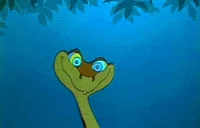This feisty little creature would be the hands-down winner in any Halloween costume contest. Although it does a heck of a job disguising itself as a snake, it is really a Hawk Moth (Hemeroplanes triptolemus) caterpillar. Commonly known as Snake Mimic Caterpillars, these caterpillars can be found in the rainforests of Central and South America and are undisputed masters in the art of mimicry.
 Many animals use mimicry to defend themselves from predators, or to better position themselves in the food chain (here’s a short yet comprehensive list). Some animals have developed super-sneaky ways to use mimicry to get themselves close to their preferred prey, but insects use these tricks primarily to protect themselves from predators. Caterpillars, especially, are extremely creative in their costuming (they are, after all, a favorite snack for many other creatures). The Hawk Moth caterpillar is an excellent example of this; it is pretty non-descript in its adult form, but as a caterpillar it can transform into a dramatically scary-looking pit viper.
Many animals use mimicry to defend themselves from predators, or to better position themselves in the food chain (here’s a short yet comprehensive list). Some animals have developed super-sneaky ways to use mimicry to get themselves close to their preferred prey, but insects use these tricks primarily to protect themselves from predators. Caterpillars, especially, are extremely creative in their costuming (they are, after all, a favorite snack for many other creatures). The Hawk Moth caterpillar is an excellent example of this; it is pretty non-descript in its adult form, but as a caterpillar it can transform into a dramatically scary-looking pit viper.So, how does a caterpillar turn into a snake? With a little bit of puffing up and flopping over. When the Hawk Moth caterpillar feels threatened it will drop the front part of its body off the branch or leaf it’s on and expose its underside. This action allows them to display an underside with faux snakeskin and eyespots that actually appear to glisten. To complete the masquerade, the caterpillar will puff out its head to mimic the triangular head of a venomous snake. And if that’s not enough, they sometimes lunge as if they’re about to strike. The use of eyespots and snake mimicry as a defense strategy is very effective (even if they do make comically short snakes) and, according to this research, it even works in areas where tree-dwelling snakes are rare. It seems caterpillar predators like birds and lizards are well aware that they are prey to snakes and take no chances with anything that might be a snake.
If you want to get a better look at how this snake disguise works, I have a couple videos for you to check out. In this one, if you look closely at the head of the “snake”, you can see the little bitty caterpillar legs between the fake eyes and this video shows a caterpillar transforming itself. You can see how the head of the caterpillar becomes the nose and part of the mouth of the snake. Cool stuff.
Take Care.
Submitted by Pam









No comments:
Post a Comment